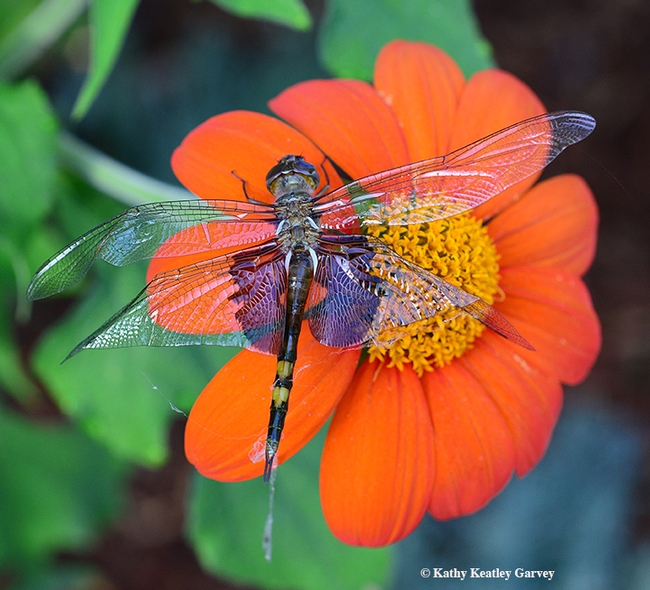- Author: Kathy Keatley Garvey
Gotta love that Gray Hairstreak.
If you don't like putting "gray" and "hair" in the same sentence, not to worry.
This is the butterfly, Strymon melinus.
When the it's hanging around a Mexican sunflower, Tithonia rotundifola, the orange spots on its tail accent the color of the flower.
"Adults visit an immense variety of flowers, both wild and cultivated," writes Art Shapiro, UC Davis distinguished professor of evolution and ecology on his website. "They are particularly addicted to Heliotrope and white-flowered Apiaceae."
"This is one of the most polyphagous butterflies known, recorded on host plants in many families. Its most frequent hosts in our area are mallows, including the weedy species of Malva; legumes, including Spanish Lotus (Lotus purshianus), Bird's-Foot Trefoil (Lotus corniculatus), White Clover (Trifolium repens) in lawns, Alfalfa (Medicago sativa) and many others;and Turkey Mullein (Eremocarpus or Croton setigerus, Euphorbiaceae)."
The Gray Hairstreak is considered a weedy butterfly. "Weedy," as Shapiro explains on his web site, "is a general term for organisms that are typically associated with habitats that are disturbed by human activities or are dominated by non-native, invasive plants."
At first glance, you don't know "which end is up"--which makes it all the better for the butterfly to escape predators.
This one allowed me to get quite close. It was more interested in the nectar than the slow movement of the long lens.
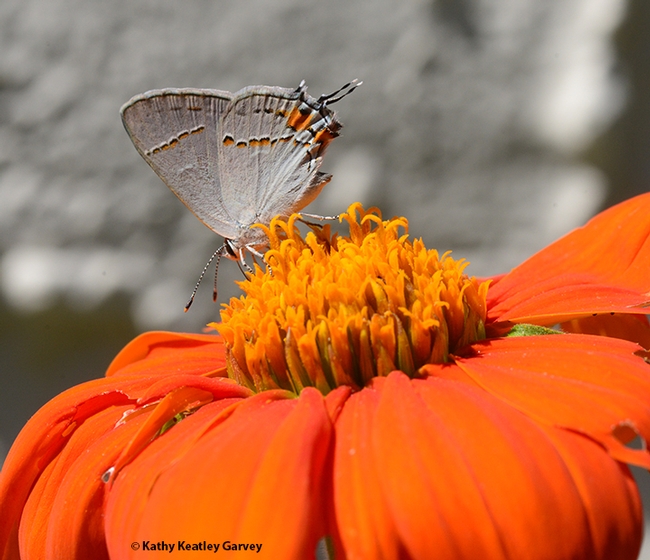
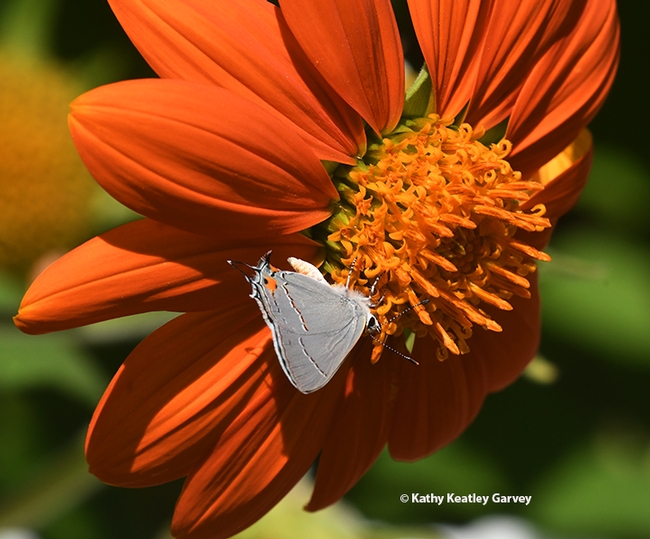
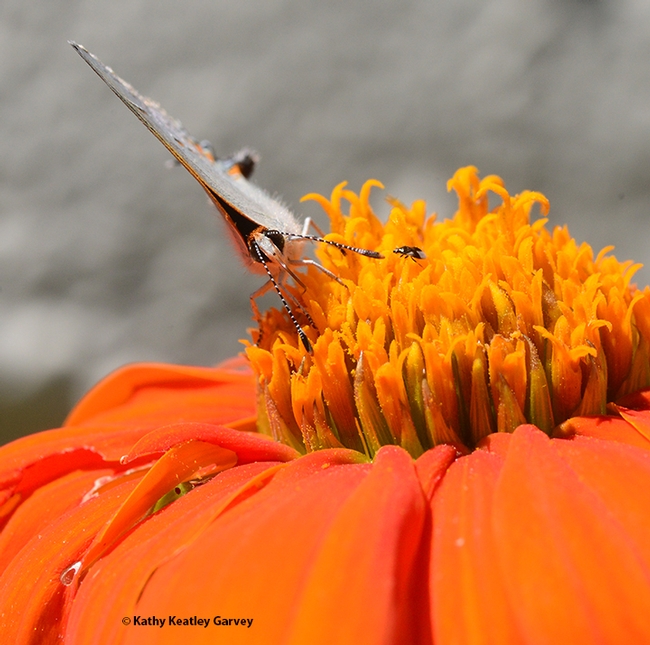
- Author: Kathy Keatley Garvey
Ready or not, here I come!
"Wait, can you slow down a bit?" I ask. "I can't focus when you move so fast!"
No, sorry! I'm in a hurry!
Anthophora urbana, a solitary, ground-nesting bee, frequents our garden to forage on the catmint (Nepeta) and lavender (Lavandula). This bee is also called an urbane digger bee (see BugGuide.net).
This one encountered a honey bee, partly obscured by the foliage, but neither seemed bothered.
California is home to more than 1600 wild bees, including A. urbana, according to the University of California-authored book, California Bees and Blooms: A Guide for Gardeners and Naturalists (Heyday). They "populate and pollinate our gardens, fields, and urban green spaces," the authors say.
That they do. And there's a very good reason why this bee is photographed more often on flowers than in flight.
Sorry, I'm in a hurry!
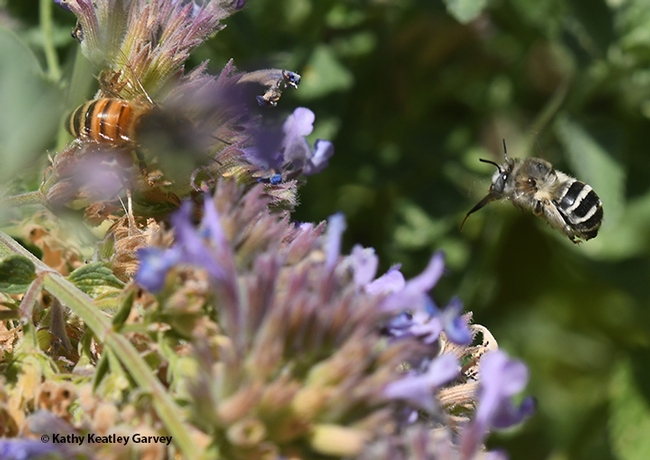
- Author: Kathy Keatley Garvey
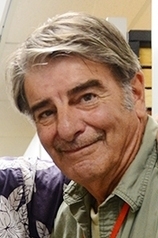
We don't normally name the monarch butterflies we rear, but we decided that the first one reared from an egg "The Greg Way" would be named for Greg--naturalist Greg Kareofelas, associate at the Bohart Museum of Entomology, UC Davis.
The first one, however, is a girl, so she's "Greta" instead of "Greg."
Over the last five years, we've reared more than hundred monarchs from caterpillar to chrysalis to adult. We collect the 'cats from the three species of milkweed in our Vacaville pollinator garden. This summer, however, we decided to collect a few eggs after seeing Mama Monarchs depositing them on tropical milkweed, Asclepias curassavica, and narrowleaf milkweed, Asclepias fascicularis. (As recommended, we cut back the tropical milkweed before the migratory season begins.)
Here's "The Greg Way":
"I put a single egg on its leaf in a small salsa container (the little plastic ones you would get at a Mexican restaurant)," Kareofelas says. "I take a square of toilet paper and fold it into a small square (3/4 of inch), dampen it and squeeze it so it is not sopping wet, just damp, and set the leaf and egg on the top. Put the lid tightly on the container. This keeps a level of moisture in the container. I check the containers daily, changing the toilet paper square to keep from molding."
The egg hatched. The caterpillar ate. And ate again, again and again. Did we mention "Again?" Again, again and again. She went through five instars, and then she j'd and formed a chrysalis on the ceiling of our indoor, netted butterfly habitat. The entire cycle from egg to larva to chrysalis to adult takes about a month. (See more on Bug Squad blog, Joy of Rearing Monarchs)
So Greta eclosed this morning, big, bold and beautiful. We released her in the pollinator garden, near where Mama deposited her as an egg. Greta inched up on a Mexican sunflower (Tithonia rotundiflora) and then took flight. A blur.
Hopefully, she will mate and overwinter in coastal California, avoiding the wildfires, adverse weather conditions and predators.
Safe travels, Greta! (And thank you, Greg!)
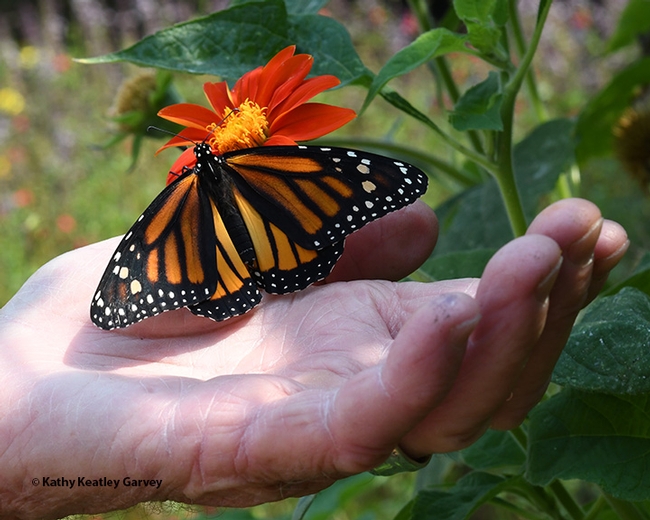
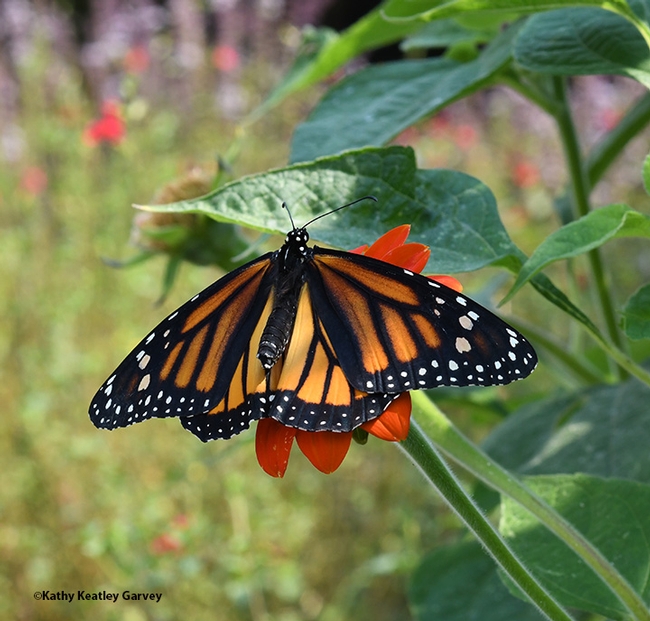
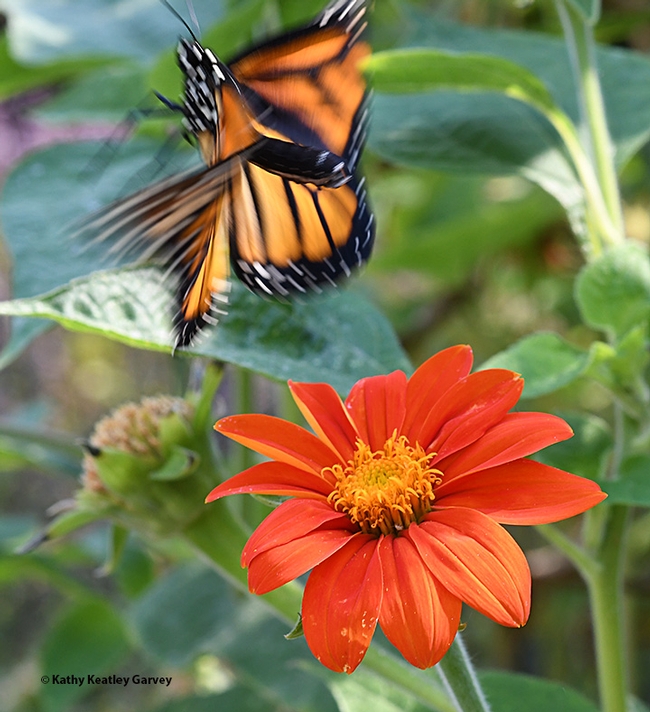
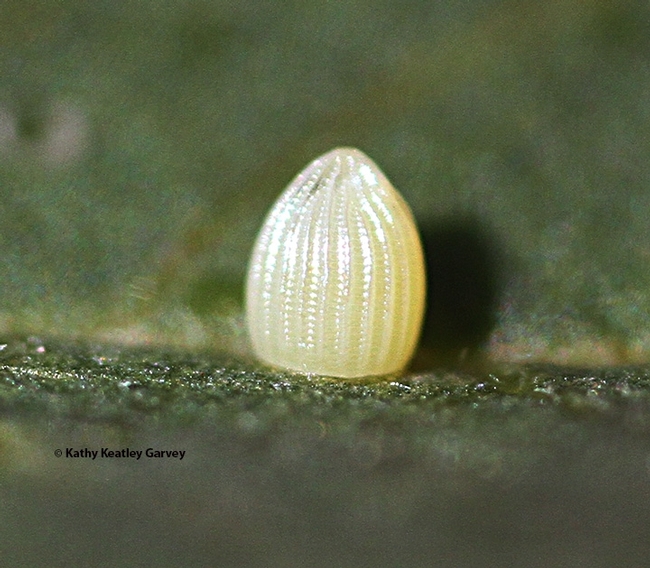
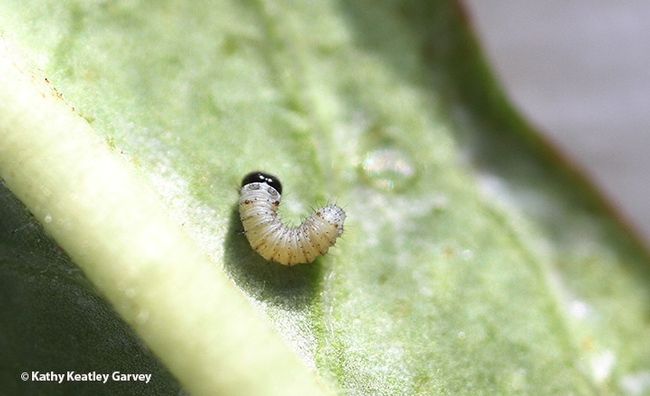
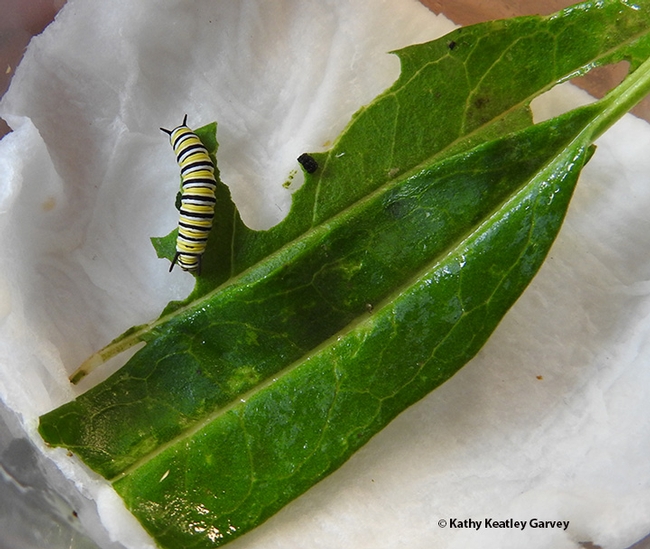
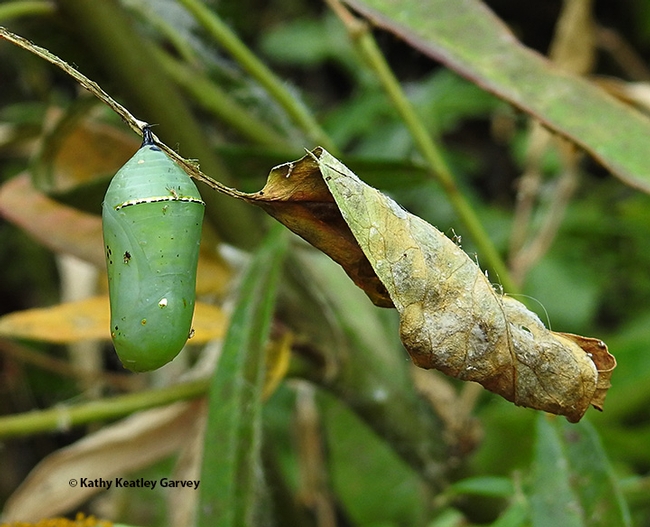
- Author: Kathy Keatley Garvey
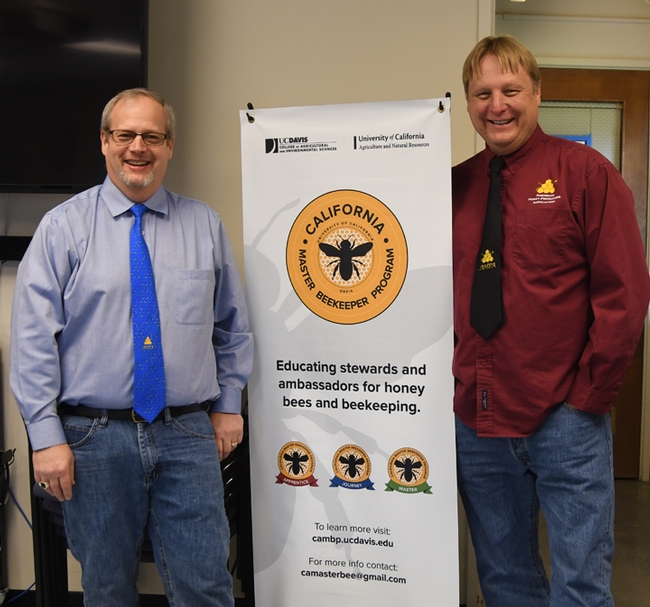
Beekeeper Kelvin Adee, who hails from Bruce, isn't experiencing any of that right now.
He's in California--and so are his bees for the almond pollination season.
Adee is the president of the American Honey Producers' Association, which is meeting Jan. 7 through Jan. 12 for the 2020 North American Honey and Pollinator Summit and Trade Show at the Hyatt Regency, Sacramento.
Adee and other members of the executive board met Tuesday morning, Jan. 7 at the Harry H. Laidlaw Jr. Honey Bee Research Facility, Bee Biology Road, University of California, Davis, for a pre-conference session. They then participated in the ribbon-cutting ceremony and tour of the newly constructed USDA-ARS bee research facility, corner of Bee Biology and Hopkins roads. (See news story)
“Is it true that the national tree of South Dakota is the telephone pole?” we asked him during the luncheon.
He laughed and said the state does indeed have wide-open spaces. The population in Bruce is sparse, too. In fact, the 2019 census recorded the population at 204.
Bruce is the home of Honey Days Festival, held the last week of July. In fact, Adee Honey Farms, known as the world's largest producer of honey (and a prominent employer in town) inspired it.
But back to Kelvin Adee. He's a third-generation beekeeper. He actually lives in nearby Brookings but works out of the home office in Bruce.
His biosketch indicates: “Growing up in a commercial beekeeping family, Kelvin developed his interest in beekeeping at a young age, learning the business and the science from his father. As a third-generation beekeeper, he also gathered beekeeping knowledge from his grandfather, uncles and cousins who have been involved in beekeeping operations." Adee attended college in Bartlesville, Okla., receiving a bachelor's degree in business and accounting. and then returned to the beekeeping business. He has been actively involved in growing the business into an 80,000 colony farm operating in multiple states, according to the biosketch. He oversees the queen rearing/nuc operation in Mississippi and Texas along with company-wide honey production.
His biosketch also relates: “In addition to beekeeping, Kelvin has served on boards in various positions for the state beekeeping association and the national association. He is active in his community and his church and has served numerous years on the school board. Kelvin married his high-school sweetheart Darla and recently celebrated 37 years of marriage. They have four grown sons and five grandchildren. Three of Kelvin's sons have joined him working full time in the beekeeping business, and the fourth son works in crop production ag. He also enjoys working in the business with his father, Richard, brother, Bret and his sister Marla.”
Meanwhile, it's brrrr cold in Bruce, but here in the Davis area, it's warming up. Plants such as tidy tips, Kniphofia "Christmas Cheer" and manzanita are blooming on the UC Davis campus.
Almonds usually start blooming around Valentine's Day, heralding the beginning of almond pollination season. Hear that buzz? No? It's coming.
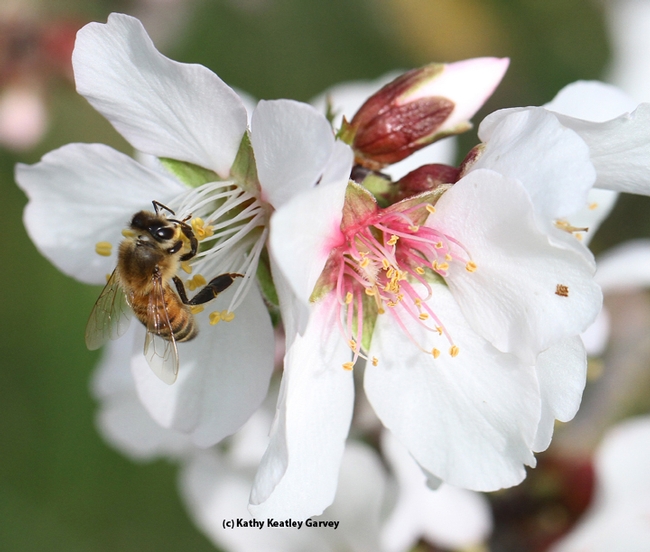
- Author: Kathy Keatley Garvey
It's always a good day when you encounter a dragonfly on Main Street USA.
Such was the case on Wednesday, July 17 when seemingly out of nowhere, a shiny Tramea lacerata "black saddlebags" appeared in front of me on the sidewalk fronting the Vacaville Chamber of Commerce.
Its habitat is near ponds, lakes, ditches, slow streams, or other bodies of water, but there it was.
"It is a freshly emerged female, probably on its maiden flight," said naturalist Greg Kareofelas of Davis, an associate with the Bohart Museum of Entomology, University of California, Davis. "This is its most vulnerable time. If it gets through the next day or so, off to fast flying it will go and you will never get close to it again."
I gingerly picked it up and photographed it on a Mexican sunflower (Tithonia). Half an hour later, I witnessed it fly over our fish pond, never to be seen again. At least by me!
This species, found throughout North America, is included in a Bohart Museum's poster, "Dragonflies of California." Designed by Fran Keller (then a doctoral student in entomology at UC Davis and now an assistant professor at Folsom Lake College), with images by Kareofelas, the poster is available in the Bohart Museum's gift shop in Room 1124 of the Academic Surge Building on Crocker Lane, UC Davis campus.
The black saddlebags dragonfly belongs to the Order Odonata (dragonflies and damselflies), suborder Anisoptera (dragonflies) family Libellulidae (skimmers), genus Tramea (saddlebags) and species lacerata (black saddlebags). "It flies constantly, often gliding, perches infrequently," according to BugGuide.net. The University of Michigan biokids website yields more information.
It's easily distinguishable. Says Wikipedia: "It has distinctive wings with characteristic black blotches" at its proximal ends, "which make the dragonfly look as though it is wearing saddlebags. The black saddlebags is a relatively large dragonfly at about 5 centimeters in length. The body is thin and black, and the female may have lighter spotting or mottling dorsally. The head is much wider than the rest of the body and is dark brown in color...Some populations of this dragonfly undertake migrations. Both the larvae and adult forms are efficient predators of mosquitoes so they are a helpful insect to have in wet areas where mosquito infestations occur." A wonderful predator...
Of predators, sidewalks and black saddlebags...
